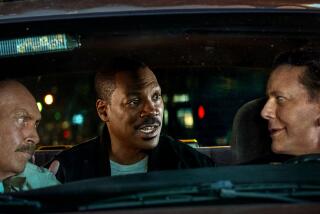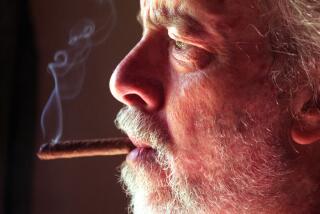‘New face of theater’
They used to say: “Go West, young man.” These days, the cry might be amended to: “Go West, experimental artist of any age” -- at least, if what’s happening at CalArts’ Center for New Performance is an indication.
Director-designer Richard Foreman, an inveterate fixture of Manhattan’s avant garde theater scene, and Michael Gordon, the composer best known as a co-founder of contemporary art music’s Bang on a Can Festival, have made their way to L.A. for their first collaboration. The new “rock opera,” called “What to Wear,” opens Wednesday at REDCAT, presented by CNP.
CNP, the artistic entity formerly known as the Center for New Theatre, is the organization behind such projects as Travis Preston’s all-female “King Lear,” staged in 2002 in a former brewery downtown and in Dijon, France, in 2003; Peach Blossom Fan in 2004; and Stephen Dillane’s one-man “Macbeth,” which premiered at REDCAT in 2004, traveled to London in 2005, and to Sydney, Australia, and the Adelaide Arts Festival this year.
“This shift in name signifies a dramatic expansion of mission,” explains artistic director Preston. “The change to the Center for New Performance is meant to embrace the work of all performance disciplines and our dedication to interdisciplinary work. More important, though, it’s that we must become leaders in the making of challenging work. It’s a compelling and necessary function of an art school -- particularly one like CalArts, dedicated as it is to experimental work.”
Foreman typifies the kind of artist with whom CNP intends to work. “There’s nowhere else in the country that will support this kind of work to this extent,” says the director, who founded his Ontological-Hysteric Theater in New York in 1968. “What artists need and often don’t get in the theater is to explore and continually change their mind. CalArts understands that.”
What’s more, CNP’s reputation is spreading. “The Center for New Performance is the new face of theater in this country,” says Robert Blacker, former artistic director of the Sundance Theatre Labs who is now teaching at the Yale School of Drama. “It breaks down boundaries and points the way to the future. Its home is in L.A. because Los Angeles is the new face of America, the city that looks most like what the United States is and will be.”
As with most Foreman works, “What to Wear” is more a matter of theme and variations than linear narrative. The plot, such as it is, consists of what Foreman describes as “people being stressed about how to present themselves in a world that is basically unsatisfactory, not working out.”
The big moment is an invasion “of these large, frightening, funny ducks,” Foreman says. “They are duck-gods or demons that manifest themselves and interfere with this concern of ‘How do I dress, how do I present myself?’ ”
Why a duck? “What I’m always interested in is finding out what associative things are going on beneath the surface,” he says. “Not that there’s much narrative in this, but generally what’s going on, on a narrative, normal level of negotiating one’s way through life, is not for me what’s really happening.”
The piece is performed by an ensemble of 10 actors, 10 singers and seven musicians. The singing is amplified, but is sung by trained singers rather than singing actors.
“What to Wear” is Foreman’s second venture with CalArts. It was scheduled for last year, but shortly before rehearsals started Foreman was hospitalized for a triple bypass and valve replacement. His first piece, “Bad Behavior,” was performed in 2000 at the Valencia campus, before REDCAT existed.
“When I came to CalArts, Richard was one of the first artists that I felt had to be a part of our work,” says Preston, who was instrumental in luring Foreman to California. “Foreman is one of few American directors who have claimed the theater as art. He holds a seminal position in the development of American theater since the mid-20th century. And he is someone who is tirelessly searching through his art.”
And Foreman may not be alone in coming west to work. “Richard Foreman, a quintessential New Yorker, has become part of the march west that many pioneers have made, to find fertile ground in California,” notes Blacker, who was a co-founder of the revived La Jolla Playhouse in the early 1980s.
After “Bad Behavior,” Preston gave Foreman an open invitation to return, and the artist soon proposed the collaborative effort with Gordon -- a work that had its genesis about seven years ago, when the director came upon a Gordon CD in New York.
Foreman contacted Gordon, and the two artists agreed on the theme of fashion in a bad world. Then Foreman set to work. “The way that I work is that I have piles and piles of dialogue and notes, like a journal,” says Foreman, whose signature style is Brechtian in its use of bright lights, often focused toward the audience, and long strings that run from point to point across and throughout the stage, dissecting the scenes. “And as usual, I collaged a libretto.”
It took about two years before anything was written. “He handed me this libretto, and it was 60 pages long, and I couldn’t understand a word of it,” Gordon recalls. “Two weeks later ... it was 30 pages. Two weeks later ... and it was 15 pages. And I still had a very difficult time figuring out what I was going to do with it.”
Foreman prefers to give composers free rein. “When he handed me the last libretto, he said I was free to set or not set any of the words,” Gordon says. But Foreman was clear about one thing: “He said, ‘There’s a duck that comes into this play at Scene 10, and I want to keep the duck.’ ”
The composer obliged, but not entirely. “There was a point where he had written in references to the duck swinging a golf club, and I didn’t set that,” Gordon says. “I think that was the only moment of disappointment for him. Maybe the piece is fatally flawed because of that, I don’t know.”
*
‘What to Wear’
Where: REDCAT at Walt Disney Concert Hall, 631 W. 2nd St., L.A.
When: 8:30 p.m. Wednesday-Sunday
Ends: Oct. 1
Price: $36-$40
Contact: (213) 237-2800
More to Read
The biggest entertainment stories
Get our big stories about Hollywood, film, television, music, arts, culture and more right in your inbox as soon as they publish.
You may occasionally receive promotional content from the Los Angeles Times.






